Realisation & Distribution of Assets by Liquidator: IBC
Page Contents
Waterfall mechanism under Liquidation under the IBC 2016:

- Under section 53(1) of the Insolvency Code, 2016, the fees payable to the liquidator shall be deducted proportionately from the proceeds payable to each class of recipients, and the proceeds to the applicable recipient shall be dispersed after such deduction.
- Both the IBC and the Insolvency and Bankruptcy Board of India (Liquidation Process) Regulations, 2016 (hence referred to as the “Liquidation Regulations”) deal with the process of corporate debtor liquidation.
- A liquidator is appointed by the Adjudicating Authority to carry out the liquidation procedure. Once the corporate debtor’s liquidation procedure has begun, its assets will be sold and dispersed among creditors, workers, shareholders, partners, and others in the sequence of priority established by the Code. The most essential part of the liquidation procedure is the distribution of the net proceeds of the corporate debtor’s assets according to priority. The “waterfall mechanism” is another name for the priority order.
LIQUIDATOR REPORTS:
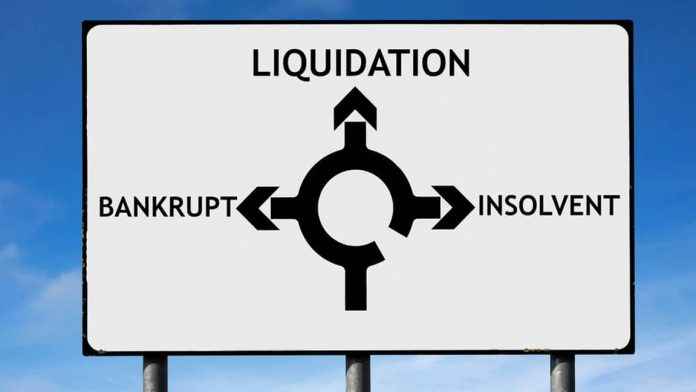
Under the Liquidation process, The Liquidator must prepare and submit the below details as per Regulation 5 of the Liquidation Regulations under the Insolvency and Bankruptcy Code, 2016:
- A preliminary report within seventy five days of liquidation starting date as per of the Liquidation Regulations under the IBC Code, 2016,
- An details of Company Asset memorandum;
- All the Progress reports on quarterly basis of the company;
- Complete breakup of Sale report of the Company
- Minutes of consultation with stakeholders; &
- Final Report prior to dissolution to the Adjudicating Authority
Liquidator should also get accounts completed & brought up to date, wherever they are found incomplete. Liquidator appointed is also needed to maintain ledgers, cash book, vouchers and various registers for security, investment & Assets. Moreover, In such a cases Liquidator is required to preserve electronic copy as well as physical copy of the said reports along with books of accounts for eight years after dissolution of the company under the Insolvency and Bankruptcy Code, 2016.
DISTRIBUTION OF ASSETS UNDER THE LIQUIDATION REGULATIONS:
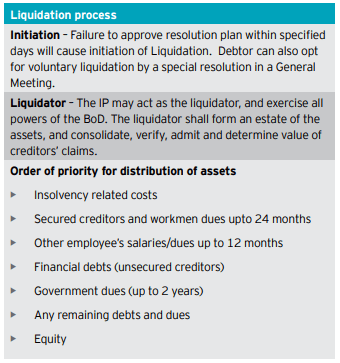
Under the Liquidation process, Distribution of assets of Corporate Debtor in liquidation is done as per under Section 53 of the IBC Code as per of the Liquidation Regulations: popularly known as ‘waterfall mechanism’. The order of priority in distribution of proceeds from liquidation estate is as follows under the of the Liquidation Regulations:
Liquidation under the IBC 2016 with special focus upon priority of claims :
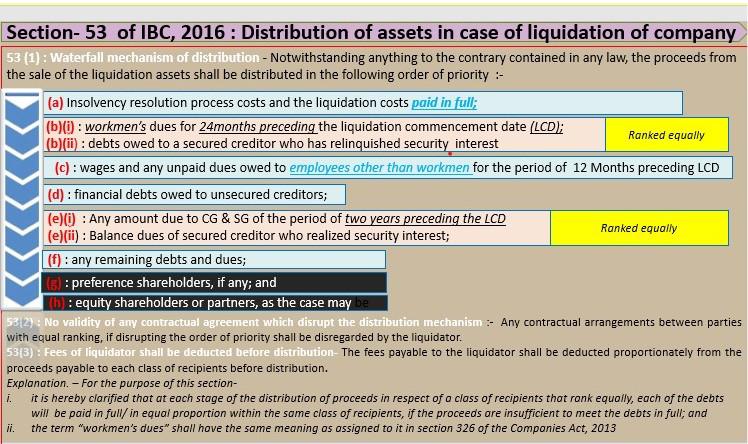
- Liquidation costs paid in whole amount: This includes Fee of Liquidator as well as costs incurred in engaging advisers, in protecting the assets, running the business, interest on interim finance etc.
- Debts of the secured outstanding creditor where he opts to relinquish security & outstanding dues of workmen for twenty four months immediately preceding start of liquidation shall rank equally. It is highlighted that secured creditor has the option of either enforcing his security or leaving it to the liquidator to realize and receive disbursement as per this mechanism.
- outstanding Wages and unpaid outstanding dues owed to employees other than workmen for the period of twelve months preceding the liquidation start date.
- Financial debts owed to unsecured outstanding creditors.
- Below outstanding dues must be rank equally between and among the following:
- any outstanding amount due to the State Govt as well as Central Govt & other Govt outstanding dues for period of Two years preceding liquidation start date as per the Liquidation Regulations.
- Outstanding debts owed to a secured creditor for any amount outstanding unpaid following enforcement of security interest
Key Note: Govt outstanding dues being placed on a lower priority is a big departure from prior legislations of the Liquidation Regulations:
- Any other debts & outstanding dues;
- All the Preference shareholders, if any; &
- Partners or Equity shareholders, as the case may be in the end.
The liquidator fee payable must be deducted proportionately from outstanding proceeds payable to each class of recipients & amount distributed to relevant recipient after such deduction as per of the Liquidation Regulations:
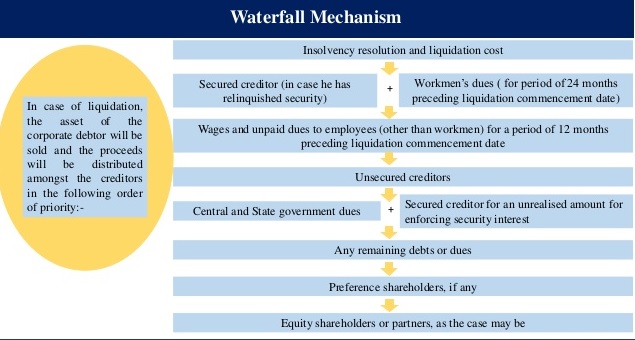
Priority of claims of operational creditors Vs financial creditors.
The financial creditors are granted priority over operational creditors in the settlement of their due amounts, as is clear from a simple reading of Section 53 and the waterfall process set forth therein. The operational creditors fall under the heading of “remaining debts and dues,” whereas the financial creditors have been expressly enrolled under Section 53.
In the matter of Binani Industries v. Bank of Baroda & Anr. before the Hon’ble NCLAT in New Delhi, the Hon’ble Tribunal decided that Section 53 is discriminatory towards operational creditors and that operational creditors should be given priority over financial creditors in terms of asset allocation. The Binani decision was likewise upheld by the Supreme Court.
Following that, in the case of Swiss Ribbons Pvt. Ltd. v. Union of India, the constitutional validity of Section 53 of the IBC was challenged before the Hon’ble Apex Court. The Hon’ble court concluded that the priority sequence enumerated under Section 53 has to be followed only during the corporate debtor’s liquidation, not during CIRP approval. Furthermore, because financial creditors and operational creditors do not have the same relationship with the corporate debtor, the Hon’ble Court stated that financial creditors are given priority over operational creditors. When opposed to an operational creditor, the debt owed to a financial creditor is bigger. As a result, Section 53 of the Code does not violate Article 14 of the Constitution and is founded on discernible distinctions.
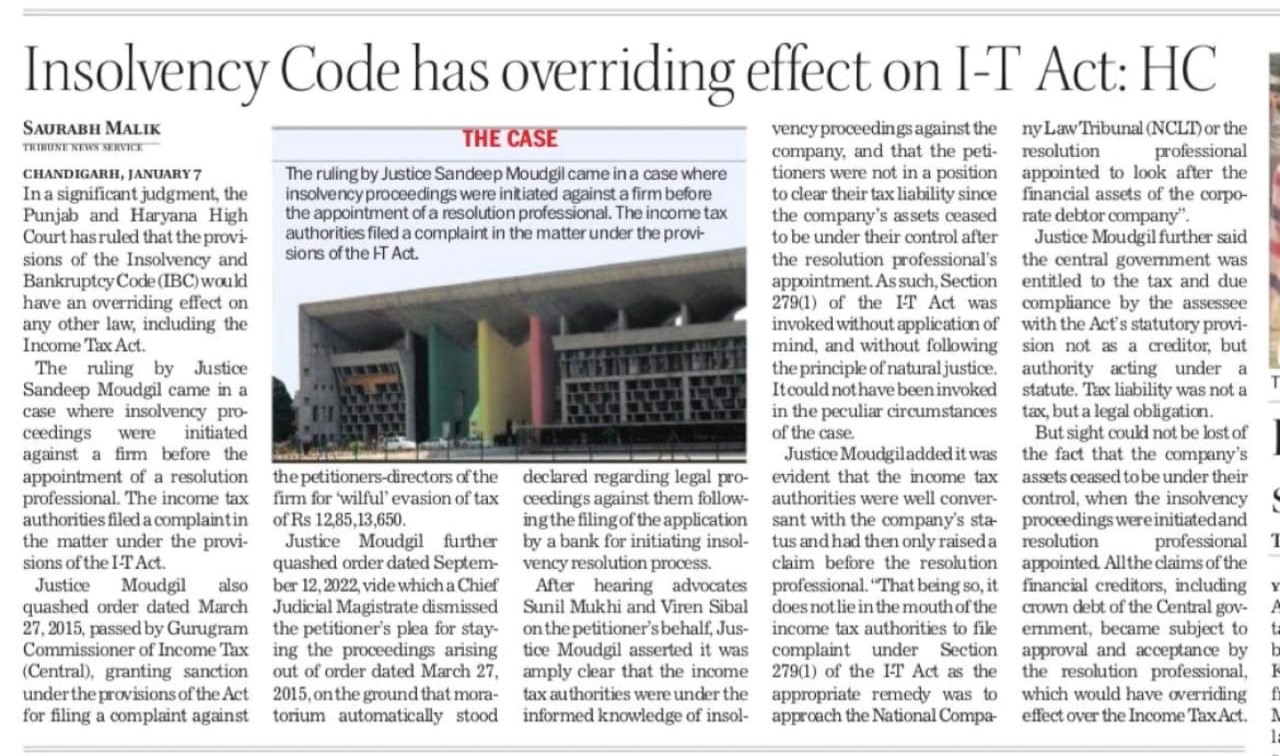
Recent Major SC decision on waterfall mechanism
Waterfall Mechanism in IBC Code, 2016 vs. in Companies Act, 2013 – Moser Baer Karamchari Union Thr. President Mahesh Chand Sharma Vs. Union of India and Ors. – Supreme Court
Summary
The purpose of implementing the IBC was to rehabilitate and revive the corporate debtor to the point where it could carry on its business on its own. The liquidation process is not intended to be a replacement for the resolution process, but rather a final resort if the settlement process fails. Furthermore, the Hon’ble NCLAT and the Judiciary have frequently concluded that even if a corporate debtor is liquidated, the liquidator should attempt to restore and continue the corporate debtor’s business.
Popular blog:-
- How does the Role of Resolution Professional help under IBC
- Fresh IBC has been suspended for one year. As per the declaration of FM.
- IBC Forms Insolvency and Bankruptcy Code 2016 Forms Demand Notices Returns
- Overviews of Principles of Avoidable Preferential Transactions IBC-2016
